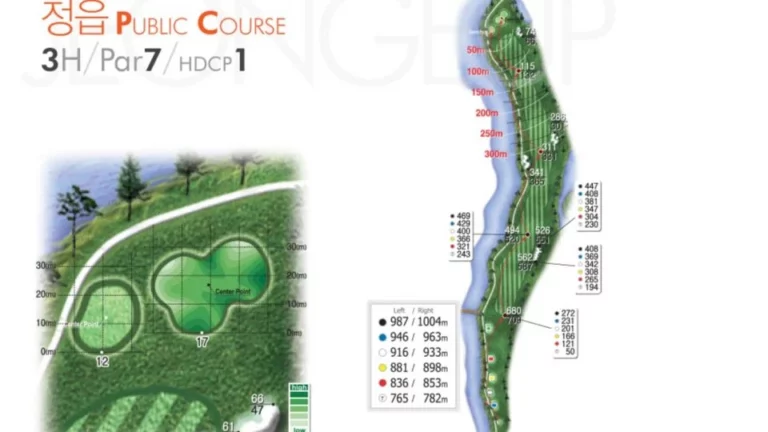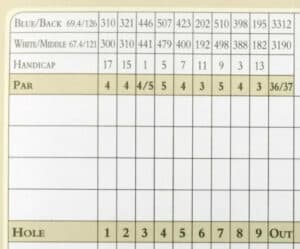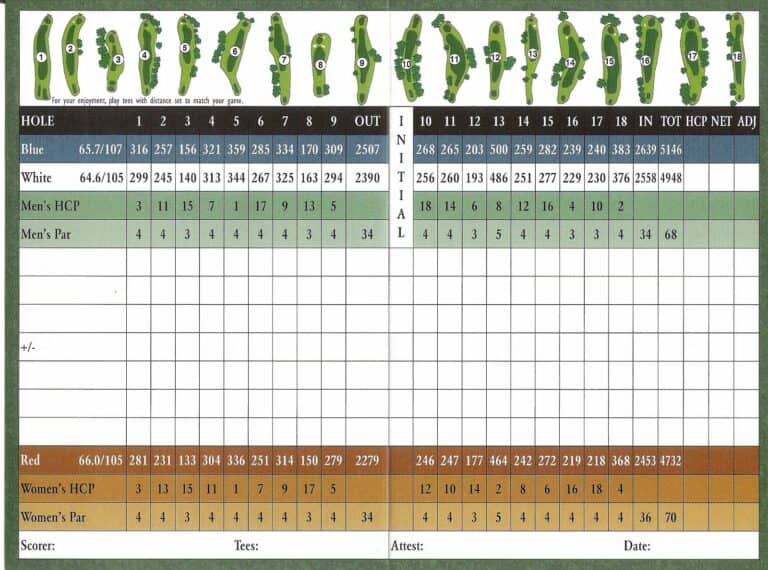- Updated: October 3, 2022
What is Par in Golf?
A par in golf is the number of strokes expected for you to get the ball in the hole.
It is a standardized score established for a single golf hole, based primarily on its length. The par of a golf hole is the average number of strokes to complete the hole from your decided tee box.
The calculation adds the number of shots expected to reach the green and two putts once on the green to complete the hole. However, it is not required to have two putts for a golfer to achieve Par, just that the total number of strokes taken is the same as the hole indicates as it’s “Par.”

The Different Types of "Par"
There are typically three types of holes on a current, regulation golf course: “Par 3,” “Par 4,” and “Par 5.”
A “Par 3” expects the golfer to reach the green in one stroke and get in the ball in the hole with two putts for three shots. Par 3’s are typically the shortest holes on the course but not necessarily the easiest.
A “Par 4” expects the golfer to reach the green in two strokes, then two-putt once on the green for four shots. Par 4s can have a wide variance of distances, ranging from a drivable yardage to over 500 yards for professional golfers.
Par 5’s expect it will take the golfer three shots to reach the green, as they will typically be the longest holes on any golf course. Players that hit the ball farther than average can take advantage of par 5s because they can get on the green with two shots instead of three. Again, two putts are expected once on the green, bringing the total shots to five.


There are always exceptions, of course. Gunsan Country Club in South Korea features a par 7 that measures 1,110 yards!
There are also instances where there are multiple “Par’s” for a single hole. For example, based on the distance of a hole, Par from the Men’s tees is 4, while Par from the women’s tees is 5. The hole’s expected score for players is shown as “4/5”
"Course Par"
Golf courses are commonly divided into two sides, or “nines,” generally referred to as the front and the back. The combined score for those holes creates the par score for each side. A typical breakdown would look like this: 36-35–71. 36 is Par for the front nine; 35 is Par for the back nine; 71 is Par for the entire course, all 18 holes.
The aggregate par score for all 18 holes on a golf course is the “Course Par” for a complete round of golf.


Most championship golf courses have a total par score ranging between 70 of 72, but there are exceptions. Kapalua Plantation, which hosts the PGA Tour’s Tournament of Champions, has a par score of 73. The Satsuki golf course (Sano) in Japan has a par score of 74.
The combination of hole types is different for every course, but the most typical breakdown is to have two Par 3s, five Par 4s, and two Par 5s per side.Measurement Against the Hole, Course & Others
Players’ scores are often given in relation to Par, especially at higher levels of golf. On an individual hole, terms like “Bogey” or “Birdie” are used to say a player’s score was one worse than Par or one better.
For an entire round, a player can say they were “5-over” to indicate their score was “5 over the total Par for the course.” This method of telling scores is advantageous when dealing with multiple-round events. Instead of saying that a player’s score after four rounds on the PGA Tour was 280 on a Par 72 course, they are shown as 8-Under-Par, as Par (72 x 4 Day Event) would be a total score of 288.
Handicap System
The golf handicap system is a numerical measure that allows players of various abilities – from recreational golfers to expert golfers – to compete fairly against one another. A player’s unique “handicap index” is calculated based on previous scores. That index coincides with the number of shots a player takes off their score or, for highly skilled players, the number added to their score. The value for a given index differs between courses as it considers a course’s difficulty.
Par in Stroke Play vs. Match Play
If Player A is a 10 handicap and Player B is a 15 handicap, Player B would get five shots taken off their score compared to Player A’s. Whichever score is lower after factoring in handicap wins a stroke play match.
If the same two players were playing match play, Player B would get a single stroke compared to Player A’s score on the five most difficult holes on the course because there is a difference of five between the players’ handicaps. Each hole’s difficulty is indicated by its “handicap ranking.” Holes are ranked from 1 to 18, with 1 being the hardest and 18 being the easiest.
Golf scoring terms
The Good
Birdie – one shot less than Par on a single hole. A score of three on a par 4 is a birdie. Typically, a birdie is also indicated with a circle around it on the scorecard.
Eagle – two shots less than Par on a single hole. A score of three on a Par 5 is an eagle. An eagle typically has a double circle around it on the scorecard.
Albatross/Double Eagle – three shots less than Par on a single hole. A score of two on a Par 5 is an Albatross or double eagle. An Albatross is much rarer than the more-revered hole-in-one, but you are more likely to get struck by lightning than card a double eagle.
Condor – a hole-in-one on a Par 5. Truly the rarest of all scores in golf. As of 2021, there were only known to be five condors in recorded history.
Scratch Golfer – a player with a handicap index of zero, is known as a scratch golfer.
The Bad
Bogey – one shot more than Par on a single hole. Typically, a Bogey is shown with a square drawn around it on the scorecard.
Double Bogey – two shots more than Par on a single hole. A double bogey is commonly drawn on the scorecard with a double square around it.
The Ugly
Triple Bogey – three shots more than Par on a single hole.
Quadruple Bogey – four shots more than Par on a single hole. Typically, this is the last specific name for a score over Par. Anything over a quadruple bogey is usually called an ‘Other.’
About The Author
Writers of Independent Golf Reviews
Independent Golf Reviews has tested and reviewed 1000+ golf products over the past 10 years. We use our experience and expertise to give golfers an unbiased insight on the market.
Read more…
Share
Receive the best golf discounts available exclusively for our subscribers and be auto entered into our monthly golf giveaways!
Success!⛳️
You are now an official member of IGR. Keep an eye out for the perks.
No spam, ever. 🔒

